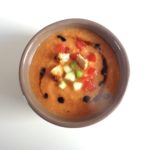 Sumer is icumen in… Yes, summer’s on its way, and with it gazpacho season. This flavor-packed chilled soup, which arrived in France from Spain, has many variants — including in spelling and pronunciation. The standard ingredients are tomatoes, cucumber, green pepper, garlic, dried bread, olive oil, vinegar, salt and pepper. My brother’s very excellent Californian version also includes spices: cumin, cinnamon and cayenne.
Sumer is icumen in… Yes, summer’s on its way, and with it gazpacho season. This flavor-packed chilled soup, which arrived in France from Spain, has many variants — including in spelling and pronunciation. The standard ingredients are tomatoes, cucumber, green pepper, garlic, dried bread, olive oil, vinegar, salt and pepper. My brother’s very excellent Californian version also includes spices: cumin, cinnamon and cayenne.
Gaspacho / Gazpacho
Of course it’s best to wait for red, ripe tomatoes before embarking on gazpacho. They’re already on the market here in Paris, imported from Italy and Spain. And we’ve been having a heat wave. So I made some the other day — very simple, providing you have a blender — and my lunch guests couldn’t have been more delighted. As garnish I added small cubes of cuke, tomato and pepper, along with little croutons and a swirl of balsamic.
I was curious, however, to know why ‘gazpacho’ is spelled ‘gaspacho’ in French. According to Le Grand Larousse Gastronomique, the dish originated in Seville, the capital of Andalusia (spelled Andalucia in Spanish, Andalousie in French). In most countries it retains the Spanish spelling, with a ‘z’, but in Spain this ‘z’ is not pronounced as a ‘z’. ‘Gazpacho’ is spoken, lispingly, as gath-PA-cho in most of Spain, and as gass-PA-cho in the south, including Seville. In France it retains the ‘s’ sound.
Research into the French spelling turned up nothing conclusive, so I will offer an explanation: a ‘z’ would change the pronunciation. The French word for natural gas, for example, is ‘gaz’, pronounced GAHZ. To retain the ‘s’ sound, the French had to change the spelling when the soup crossed the Pyrenees. This being France, the soup is of course pronounced differently anyway, with the accent on the last syllable: gass-pa-CHO.
From a cook’s point of view, this is all academic. What matters is the sublime mixture of flavors in this soup, which has been adapted to culinary styles around the world. I first made gazpacho when working as a substitute chef at Moosewood, an American pioneer in healthy natural cuisine. This was in the ’70s in Ithaca, New York, and gazpacho was already part of the American culinary repertoire.
Upon moving to Paris, I was delighted to find that gazpacho was popular here, too. French recipes tend to stick close to the Spanish original, as does the one in this post.
I first tasted my brother’s version a few summers back when we visited the California ranch of friends of his. It was a sunny, hot, lazy day, my daughter and I were in the pool, Bruce disappeared into the kitchen and emerged with beautiful soup — spicy and topped with avocado bits. I’ve included his version in the recipe.
Bruce is also responsible for me starting this post with a phrase from a medieval English round known as the ‘Cuckoo Song’. When very young, he made a water painting of a singing cuckoo with that phrase across the top. It was so lovely that my mother framed and hung it. Little did she know that her number one son would grow up to be an artist.
So with summer a-comin’ in, and the cuckoo starting to sing (and with my apologies for the mixed metaphor), go gather ye tomatoes while ye may, for gazpacho season is upon us.
Happy cooking.

 One of the pleasures of spring is fresh peas, and one of my favorite ways to serve them is in pasta with dry-cured ham and cream. The flavors marry delightfully, and the dish takes only moments to prepare. The only problem this spring, with farmers markets closed in France, has been getting hold of the peas. I found some the other day at an improvised veggie stand set up by chef Rodolphe Paquin of Le Repaire de Cartouche.
One of the pleasures of spring is fresh peas, and one of my favorite ways to serve them is in pasta with dry-cured ham and cream. The flavors marry delightfully, and the dish takes only moments to prepare. The only problem this spring, with farmers markets closed in France, has been getting hold of the peas. I found some the other day at an improvised veggie stand set up by chef Rodolphe Paquin of Le Repaire de Cartouche. Back to Rodolphe Paquin, a genial fellow and one of my favorite chefs (I interviewed him a few years back — you can read the interview
Back to Rodolphe Paquin, a genial fellow and one of my favorite chefs (I interviewed him a few years back — you can read the interview  This delightful spring dessert of meringues topped with strawberries and whipped cream is, oddly, unknown in France, at least not as schaum torte. The recipe stems from my childhood in Wisconsin, where schaum torte (‘foam cake’) was popularized by the large German-descended community. My mother sometimes made it with wild strawberries gathered by me and my brother in the fields around our house. Does this sound delicious? It is.
This delightful spring dessert of meringues topped with strawberries and whipped cream is, oddly, unknown in France, at least not as schaum torte. The recipe stems from my childhood in Wisconsin, where schaum torte (‘foam cake’) was popularized by the large German-descended community. My mother sometimes made it with wild strawberries gathered by me and my brother in the fields around our house. Does this sound delicious? It is. Is it an omelet? Is it a soufflé? It’s both! Although more like an airy omelet that rises and browns delightfully in the oven to make a perfect brunch dish. This specialty of Alsace is generally served sweetened with powdered sugar and lemon, with caramelized pear or apple slices, with fresh fruit — or any of the above. Breakfast meats like bacon, ham or sausage also pair nicely.
Is it an omelet? Is it a soufflé? It’s both! Although more like an airy omelet that rises and browns delightfully in the oven to make a perfect brunch dish. This specialty of Alsace is generally served sweetened with powdered sugar and lemon, with caramelized pear or apple slices, with fresh fruit — or any of the above. Breakfast meats like bacon, ham or sausage also pair nicely. And the beauty of this dish is that it’s incredibly easy to make. Children can do it. Eggs are whisked with flour, milk and a little salt, butter is melted in a soufflé dish or high-sided cake pan, the batter poured in and — presto! — after 2o minutes in the oven, it’s ready. While it is baking, you can sauté some apple or pear slices in butter, adding a little sugar at the end to caramelize.
And the beauty of this dish is that it’s incredibly easy to make. Children can do it. Eggs are whisked with flour, milk and a little salt, butter is melted in a soufflé dish or high-sided cake pan, the batter poured in and — presto! — after 2o minutes in the oven, it’s ready. While it is baking, you can sauté some apple or pear slices in butter, adding a little sugar at the end to caramelize. I have been enjoying this dish since childhood, thanks to my Grandma Hilda, who passed the recipe along to my mother. Hilda had no Alsatian ancestry as far as I know, but her husband, my Grandpa Herb, did. According to family lore, one of his second cousins, Nettie Harris Hirsch, inherited two pewter plates made in Alsace in the 1700s and inscribed ‘Be Kosher’ in Yiddish.
I have been enjoying this dish since childhood, thanks to my Grandma Hilda, who passed the recipe along to my mother. Hilda had no Alsatian ancestry as far as I know, but her husband, my Grandpa Herb, did. According to family lore, one of his second cousins, Nettie Harris Hirsch, inherited two pewter plates made in Alsace in the 1700s and inscribed ‘Be Kosher’ in Yiddish. As it is currently Passover, this particular omelet, which contains flour, cannot be enjoyed by anyone who wishes to keep kosher. But Passover ends on Thursday evening, and in the meantime there’s Easter. So for a fabulous Easter brunch, mix up some
As it is currently Passover, this particular omelet, which contains flour, cannot be enjoyed by anyone who wishes to keep kosher. But Passover ends on Thursday evening, and in the meantime there’s Easter. So for a fabulous Easter brunch, mix up some  In these stay-at-home days, comfort food beckons. And this dish of chicken, ham and melted cheese answers the call. It’s fun to make — the whole family can take part. Chicken breasts are butterflied (sliced almost in two horizontally), filled with ham and cheese, folded together, dipped in flour, egg and breadcrumbs, and cooked — sautéed, then baked — to golden perfection.
In these stay-at-home days, comfort food beckons. And this dish of chicken, ham and melted cheese answers the call. It’s fun to make — the whole family can take part. Chicken breasts are butterflied (sliced almost in two horizontally), filled with ham and cheese, folded together, dipped in flour, egg and breadcrumbs, and cooked — sautéed, then baked — to golden perfection. preceded by a seasonal starter — perhaps an
preceded by a seasonal starter — perhaps an  If you feel like this lull could be a good time to try your hand at gourmet cooking, why not attempt a
If you feel like this lull could be a good time to try your hand at gourmet cooking, why not attempt a  Another approach is the one-pot meal, like
Another approach is the one-pot meal, like  Family-friendly favorites that can be served as main dishes or sides include gratins of all sorts — of
Family-friendly favorites that can be served as main dishes or sides include gratins of all sorts — of  The versatility of the humble potato makes it a great ingredient in this time of limited resources. Have you ever made
The versatility of the humble potato makes it a great ingredient in this time of limited resources. Have you ever made  Pasta and rice are the staples that have been most coveted in France during the lockdown, and recipes range from the simple to the sophisticated. Some personal favorites are
Pasta and rice are the staples that have been most coveted in France during the lockdown, and recipes range from the simple to the sophisticated. Some personal favorites are  This subtle and elegant cream-filled cake is hard to find outside the French Basque country — an incentive to make it yourself. Even in Paris, it’s rare to come across a pastry shop proposing gâteau basque, which is surprising because bistros around here regularly offer other Basque dishes. Making the cake is a bit of a production — the delicate dough has to chill for a couple of hours, and is then rolled out — but the effort will win you applause.
This subtle and elegant cream-filled cake is hard to find outside the French Basque country — an incentive to make it yourself. Even in Paris, it’s rare to come across a pastry shop proposing gâteau basque, which is surprising because bistros around here regularly offer other Basque dishes. Making the cake is a bit of a production — the delicate dough has to chill for a couple of hours, and is then rolled out — but the effort will win you applause. This dynamite French-Asian fusion dish of cockles in satay sauce is the creation of John O’Shea, a young British chef at the Paris bistro
This dynamite French-Asian fusion dish of cockles in satay sauce is the creation of John O’Shea, a young British chef at the Paris bistro  What’s not to like about cheese fondue? Over here it evokes memories of ski vacations in the French Alps, where after a day on the slopes it is enjoyed in cozy chalets before a crackling wood fire. But of course fondue has emigrated far from its Alpine home and has been popular elsewhere for decades. It is a convivial dish, and if you happen to be celebrating Valentine’s Day, makes a friendly meal for two, accompanied by a crisp white wine.
What’s not to like about cheese fondue? Over here it evokes memories of ski vacations in the French Alps, where after a day on the slopes it is enjoyed in cozy chalets before a crackling wood fire. But of course fondue has emigrated far from its Alpine home and has been popular elsewhere for decades. It is a convivial dish, and if you happen to be celebrating Valentine’s Day, makes a friendly meal for two, accompanied by a crisp white wine. I first tasted this knock-your-socks-off red-bean-and-walnut salad in Moscow in 1984. Russia was still part of the Soviet Union, and young people from other parts of the empire still flocked to the capital to study or work. A friend introduced me to a Georgian woman who was studying particle physics. When she invited us over for dinner, I had no idea what to expect. Then she produced this fabulous dish. I’ve been making it ever since.
I first tasted this knock-your-socks-off red-bean-and-walnut salad in Moscow in 1984. Russia was still part of the Soviet Union, and young people from other parts of the empire still flocked to the capital to study or work. A friend introduced me to a Georgian woman who was studying particle physics. When she invited us over for dinner, I had no idea what to expect. Then she produced this fabulous dish. I’ve been making it ever since. The French tend to rave about daube de boeuf, a flavorful beef stew from Provence, without it being clear exactly why. Like Proust’s madeleine, this dish must evoke memories of childhood. And indeed, daube harks back to a simpler time, when dishes simmered for hours in a pot set over an open fire, their aroma filling the house until the family was seated to enjoy a tender moment of togetherness. But after all, it’s only beef stew — right?
The French tend to rave about daube de boeuf, a flavorful beef stew from Provence, without it being clear exactly why. Like Proust’s madeleine, this dish must evoke memories of childhood. And indeed, daube harks back to a simpler time, when dishes simmered for hours in a pot set over an open fire, their aroma filling the house until the family was seated to enjoy a tender moment of togetherness. But after all, it’s only beef stew — right?

